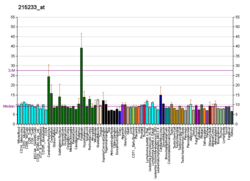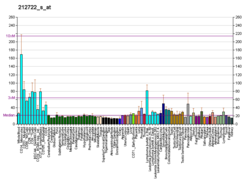Bifunctional arginine demethylase and lysyl-hydroxylase JMJD6 is an enzyme that in humans is encoded by the JMJD6 gene.
Function
This gene encodes a nuclear protein with a JmjC domain. JmjC domain-containing proteins belong to the alpha-ketoglutarate-dependent hydroxylase superfamily. They are predicted to function as protein hydroxylases or histone demethylases. This protein was first identified as a putative phosphatidylserine receptor involved in phagocytosis of apoptotic cells. Subsequent studies suggest that the protein may cross-react with a monoclonal antibody that recognizes the phosphatidylserine receptor and does not directly function in the clearance of apoptotic cells. Multiple transcript variants encoding different isoforms have been found for this gene. On a physiological level JMJD6 has a role in angiogenesis, the process of vessel formation, whereas further roles of JMJD6 in pathophysiological processes were implicated, such as mammary tumorigenesis. Here, elevated JMJD6 level were found in breast cancer associated with aggressiveness and metastasis in mice.
References
- ^ GRCh38: Ensembl release 89: ENSG00000070495 – Ensembl, May 2017
- ^ GRCm38: Ensembl release 89: ENSMUSG00000056962 – Ensembl, May 2017
- "Human PubMed Reference:". National Center for Biotechnology Information, U.S. National Library of Medicine.
- "Mouse PubMed Reference:". National Center for Biotechnology Information, U.S. National Library of Medicine.
- Vandivier RW, Fadok VA, Hoffmann PR, Bratton DL, Penvari C, Brown KK, Brain JD, Accurso FJ, Henson PM (March 2002). "Elastase-mediated phosphatidylserine receptor cleavage impairs apoptotic cell clearance in cystic fibrosis and bronchiectasis". The Journal of Clinical Investigation. 109 (5): 661–70. doi:10.1172/JCI13572. PMC 150889. PMID 11877474.
- ^ "Entrez Gene: JMJD6 jumonji domain containing 6".
- Boeckel JN, Guarani V, Koyanagi M, Roexe T, Lengeling A, Schermuly RT, Gellert P, Braun T, Zeiher A, Dimmeler S (February 2011). "Jumonji domain-containing protein 6 (Jmjd6) is required for angiogenic sprouting and regulates splicing of VEGF-receptor 1". Proceedings of the National Academy of Sciences of the United States of America. 108 (8): 3276–81. Bibcode:2011PNAS..108.3276B. doi:10.1073/pnas.1008098108. PMC 3044381. PMID 21300889.
- Aprelikova O, Chen K, El Touny LH, Brignatz-Guittard C, Han J, Qiu T, Yang HH, Lee MP, Zhu M, Green JE (14 Apr 2016). "The epigenetic modifier JMJD6 is amplified in mammary tumors and cooperates with c-Myc to enhance cellular transformation, tumor progression, and metastasis". Clin Epigenetics. 8 (38): 38. doi:10.1186/s13148-016-0205-6. PMC 4831179. PMID 27081402.
Further reading
- Boeckel JN, Guarani V, Koyanagi M, Roexe T, Lengeling A, Schermuly RT, Gellert P, Braun T, Zeiher A, Dimmeler S (February 2011). "Jumonji domain-containing protein 6 (Jmjd6) is required for angiogenic sprouting and regulates splicing of VEGF-receptor 1". Proceedings of the National Academy of Sciences of the United States of America. 108 (8): 3276–81. Bibcode:2011PNAS..108.3276B. doi:10.1073/pnas.1008098108. PMC 3044381. PMID 21300889.
- Webby CJ, Wolf A, Gromak N, Dreger M, Kramer H, Kessler B, Nielsen ML, Schmitz C, Butler DS, Yates JR, Delahunty CM, Hahn P, Lengeling A, Mann M, Proudfoot NJ, Schofield CJ, Böttger A (July 2009). "Jmjd6 catalyses lysyl-hydroxylation of U2AF65, a protein associated with RNA splicing" (PDF). Science. 325 (5936): 90–3. Bibcode:2009Sci...325...90W. doi:10.1126/science.1175865. hdl:10033/78493. PMID 19574390. S2CID 38938528.
- Zakharova L, Dadsetan S, Fomina AF (October 2009). "Endogenous Jmjd6 gene product is expressed at the cell surface and regulates phagocytosis in immature monocyte-like activated THP-1 cells". Journal of Cellular Physiology. 221 (1): 84–91. doi:10.1002/jcp.21829. PMID 19492415. S2CID 12228555.
- Hahn P, Böse J, Edler S, Lengeling A (2008). "Genomic structure and expression of Jmjd6 and evolutionary analysis in the context of related JmjC domain containing proteins". BMC Genomics. 9: 293. doi:10.1186/1471-2164-9-293. PMC 2453528. PMID 18564434.
- Chang B, Chen Y, Zhao Y, Bruick RK (October 2007). "JMJD6 is a histone arginine demethylase". Science. 318 (5849): 444–7. Bibcode:2007Sci...318..444C. doi:10.1126/science.1145801. PMID 17947579. S2CID 35792729.
- Klose RJ, Kallin EM, Zhang Y (September 2006). "JmjC-domain-containing proteins and histone demethylation". Nature Reviews Genetics. 7 (9): 715–27. doi:10.1038/nrg1945. PMID 16983801. S2CID 30005607.
- Williamson P, Schlegel RA (2005). "Hide and seek: the secret identity of the phosphatidylserine receptor". Journal of Biology. 3 (4): 14. doi:10.1186/jbiol14. PMC 549716. PMID 15453906.
- Böse J, Gruber AD, Helming L, Schiebe S, Wegener I, Hafner M, Beales M, Köntgen F, Lengeling A (2005). "The phosphatidylserine receptor has essential functions during embryogenesis but not in apoptotic cell removal". Journal of Biology. 3 (4): 15. doi:10.1186/jbiol10. PMC 549712. PMID 15345036.
- Nagase T, Ishikawa K, Miyajima N, Tanaka A, Kotani H, Nomura N, Ohara O (February 1998). "Prediction of the coding sequences of unidentified human genes. IX. The complete sequences of 100 new cDNA clones from brain which can code for large proteins in vitro". DNA Research. 5 (1): 31–9. doi:10.1093/dnares/5.1.31. PMID 9628581.
- Fadok VA, Bratton DL, Rose DM, Pearson A, Ezekewitz RA, Henson PM (May 2000). "A receptor for phosphatidylserine-specific clearance of apoptotic cells". Nature. 405 (6782): 85–90. Bibcode:2000Natur.405...85F. doi:10.1038/35011084. PMID 10811223. S2CID 205006217.
- Ajmone-Cat MA, De Simone R, Nicolini A, Minghetti L (January 2003). "Effects of phosphatidylserine on p38 mitogen activated protein kinase, cyclic AMP responding element binding protein and nuclear factor-kappaB activation in resting and activated microglial cells". Journal of Neurochemistry. 84 (2): 413–6. doi:10.1046/j.1471-4159.2003.01562.x. PMID 12559004. S2CID 29957905.
- Chan A, Seguin R, Magnus T, Papadimitriou C, Toyka KV, Antel JP, Gold R (September 2003). "Phagocytosis of apoptotic inflammatory cells by microglia and its therapeutic implications: termination of CNS autoimmune inflammation and modulation by interferon-beta". Glia. 43 (3): 231–42. doi:10.1002/glia.10258. PMID 12898702. S2CID 9085775.
- Wang X, Wu YC, Fadok VA, Lee MC, Gengyo-Ando K, Cheng LC, Ledwich D, Hsu PK, Chen JY, Chou BK, Henson P, Mitani S, Xue D (November 2003). "Cell corpse engulfment mediated by C. elegans phosphatidylserine receptor through CED-5 and CED-12" (PDF). Science. 302 (5650): 1563–6. Bibcode:2003Sci...302.1563W. doi:10.1126/science.1087641. PMID 14645848. S2CID 25672278.
- Cui P, Qin B, Liu N, Pan G, Pei D (February 2004). "Nuclear localization of the phosphatidylserine receptor protein via multiple nuclear localization signals". Experimental Cell Research. 293 (1): 154–63. doi:10.1016/j.yexcr.2003.09.023. PMID 14729065.
- Cao WM, Murao K, Imachi H, Hiramine C, Abe H, Yu X, Dobashi H, Wong NC, Takahara J, Ishida T (April 2004). "Phosphatidylserine receptor cooperates with high-density lipoprotein receptor in recognition of apoptotic cells by thymic nurse cells". Journal of Molecular Endocrinology. 32 (2): 497–505. doi:10.1677/jme.0.0320497. PMID 15072554.
- Cikala M, Alexandrova O, David CN, Pröschel M, Stiening B, Cramer P, Böttger A (June 2004). "The phosphatidylserine receptor from Hydra is a nuclear protein with potential Fe(II) dependent oxygenase activity". BMC Cell Biology. 5: 26. doi:10.1186/1471-2121-5-26. PMC 442123. PMID 15193161.
- Hong JR, Lin GH, Lin CJ, Wang WP, Lee CC, Lin TL, Wu JL (November 2004). "Phosphatidylserine receptor is required for the engulfment of dead apoptotic cells and for normal embryonic development in zebrafish". Development. 131 (21): 5417–27. doi:10.1242/dev.01409. PMID 15469976. S2CID 11188261.
- Köninger J, Balaz P, Wagner M, Shi X, Cima I, Zimmermann A, di Sebastiano P, Büchler MW, Friess H (January 2005). "Phosphatidylserine receptor in chronic pancreatitis: evidence for a macrophage independent role". Annals of Surgery. 241 (1): 144–51. doi:10.1097/01.sla.0000149304.89456.5a. PMC 1356857. PMID 15622002.
| Oxidoreductases: dioxygenases, including steroid hydroxylases (EC 1.14) | |
|---|---|
| 1.14.11: 2-oxoglutarate | |
| 1.14.13: NADH or NADPH | |
| 1.14.14: reduced flavin or flavoprotein | |
| 1.14.15: reduced iron–sulfur protein | |
| 1.14.16: reduced pteridine (BH4 dependent) | |
| 1.14.17: reduced ascorbate | |
| 1.14.18-19: other | |
| 1.14.99 - miscellaneous | |
| Enzymes | |
|---|---|
| Activity | |
| Regulation | |
| Classification | |
| Kinetics | |
| Types |
|
This article on a gene on human chromosome 17 is a stub. You can help Misplaced Pages by expanding it. |






